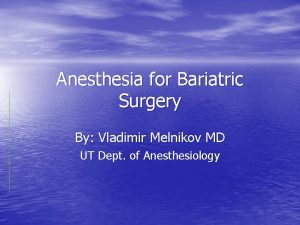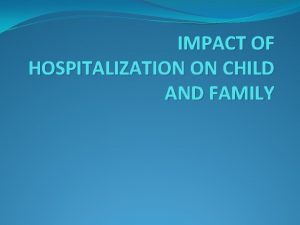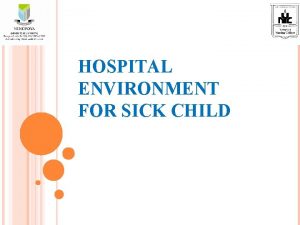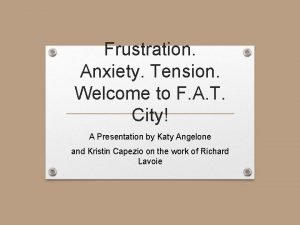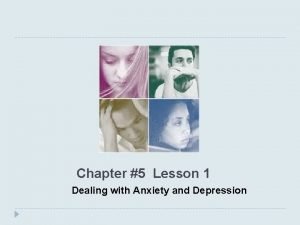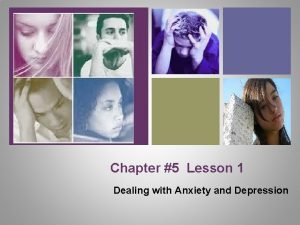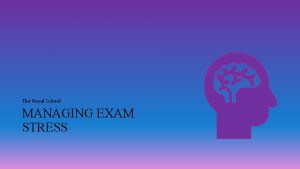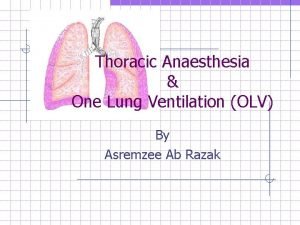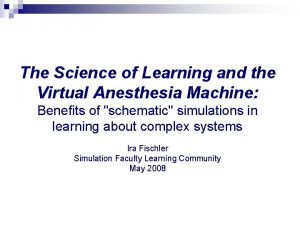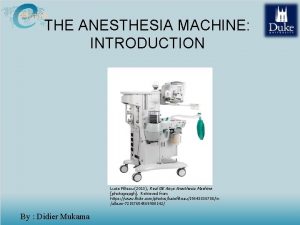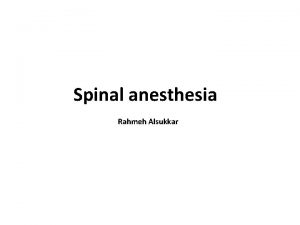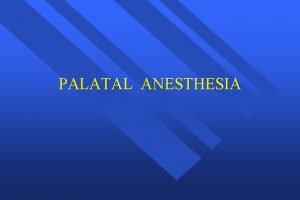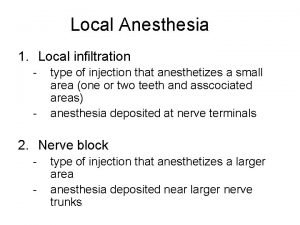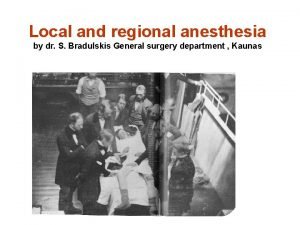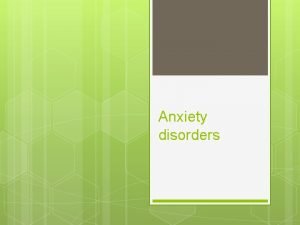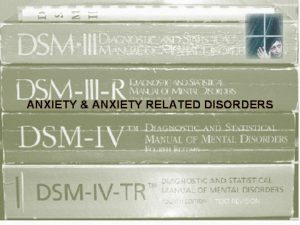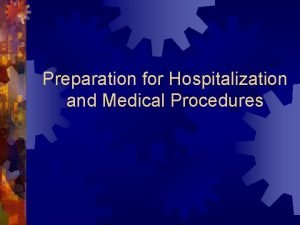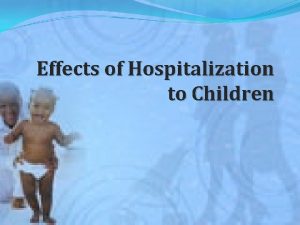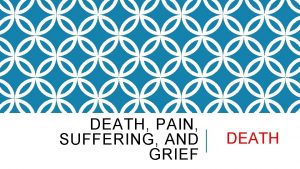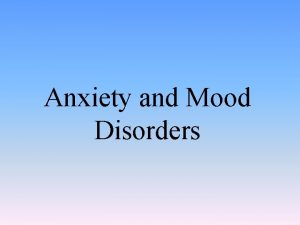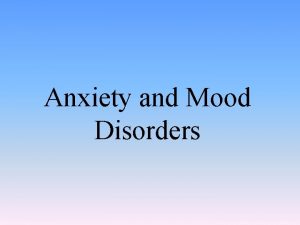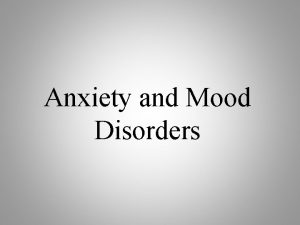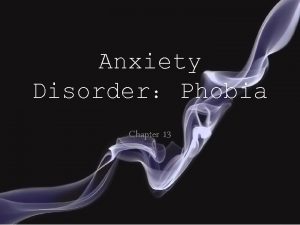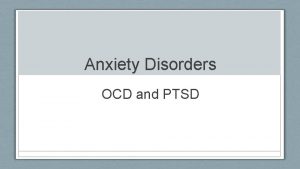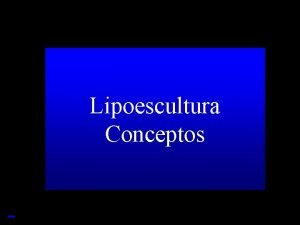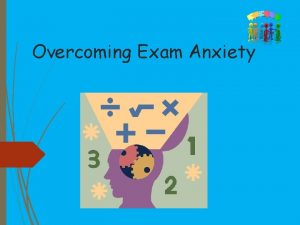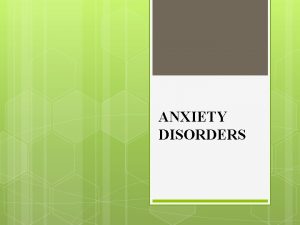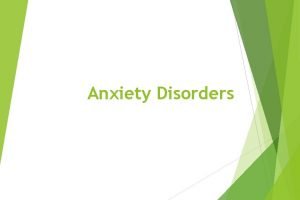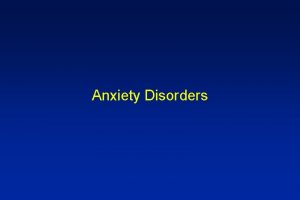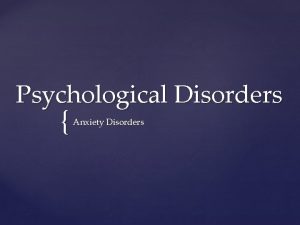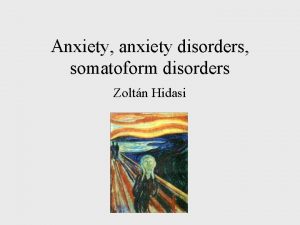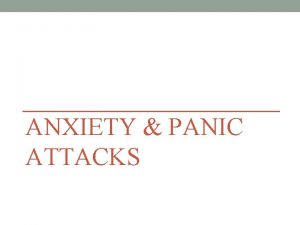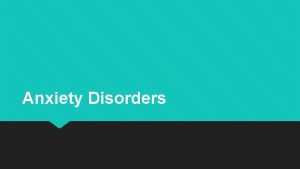Anxiety and surgery Pain SURGERY Anesthesia Hospitalization Death



























- Slides: 27

Anxiety and surgery

Pain SURGERY Anesthesia Hospitalization Death

• E. C. J. Carr et al. / International Journal of Nursing Studies 42 (2005) 521– 530

• The prospect of surgery is an extremely stressful event. • Acute pain is inextricably linked with anxiety and depression. • Patients who were anxious had significantly higher pain scores than less anxious patients and changes in anxiety were significantly related to changes in pain

Dimension on surgery • • • Physical dimension Emotional dimension Cognitive Social and family Professional

• Pre-operative anxiety and depression scores predicted post-operative experience • patients’ expectations about their pain, and concerns about its continuation or effect on their lives contributed to the degree of anxiety • Long waiting times between the onset of symptoms and being referred to a specialist may mean that they have to cope with difficult physical symptoms

• Anxiety symptoms in the postoperative period were associated with AF, to cognitive-affective and somatic anxiety symptoms • Post operative autonomic arousal symptoms were associated with AF heart & lung 4 0 ( 2 0 1 1 ) 4 -11

• significant drop in anxiety from the pre- to the postoperative period • Female patients had higher pre operation anxiety than males. • Females and males did not differ in anxiety at the post operation period • Hospitalization and surgery are very important negative life events that lead to the experience of considerable anxiety in patients

• This anxiety is related to – being ill, the – threat posed by potential surgery and the potential negative aftereffects of surgery, – the role obligations of hospitalization such as • being in a strange environment, • having unfamiliar roommates, • and the necessity to comply with medical procedures and • numerous diagnostic tests

• High preoperative anxiety leads to physical problems like – dizziness, – nausea, and – Headaches • Patients with high postoperative anxiety have longer hospitalization periods and report more postoperative pain

• Certain sociodemographic characteristics, such as : – age, gender, marital status, and education have been noted to be related to anxiety experienced by patients. – Women, young people, people with low education levels, and single individuals have been found to be more vulnerable to anxiety in the pre- and postoperative period

• Emotion focused coping may be more suitable for reducing pre- and postoperative anxiety than problem focused coping for patients • patients who perceive a high amount of social support will experience lesser anxiety as compared to those with a low perception of social support

• A. N. Karanci, G. Dirik / Journal of Psychosomatic Research 55 (2003) 363– 369

• Giving knowledge about surgery and its favorable consequences may be effective in reducing their worries. • Coping strategies seem to be related to both pre- and postoperative anxiety, although they seem to be more important for postsurgery anxiety.

• Active coping is related to postoperative anxiety, whereas – helplessness and – self-blaming anxiety are related to preoperative surgery specific anxiety

• Fear, anxiety, uncertainty, loss of control, and decrease of self esteem are emotional problems likely to be experienced by patients when confronted with the need for surgery and admission into hospital

• both patients and their families had familiarities in terms of anxiety and information needs that are more information about the procedure before the operation, operation date, the success and duration of the operation, likely occurrences after the operation such as tubes, drainage, and catheter, life style changes after the operation, and the effects of waiting for the operation on the patients and their families

• stress and anxiety can have a detrimental effect on recovery after surgery and that effective preoperative information reduces stress, anxiety and pain levels • anxiety and stress were caused by fear, lack of knowledge about a situation, or not knowing how one will cope with it, makes one unable to control events or anticipate occurrence • K. Asilioglu, S. S. Celik / Patient Education and Counseling 53 (2004) 65– 70

Figure 1. 1 ).

• Admission to hospital and the prospect of surgery is accepted as extremely anxietyprovoking resulting in behavioral and cognitive sequele which can have far reaching effects on recovery

• At most surgical facilities, there is a waiting room for patients’ friends and family. • Often there is a nurse, social worker, physician, or volunteer present to assist families with their needs and to communicate the patient’s perioperative progress

• surgical facilities provide information to family members while relatives are undergoing surgery • to provide family members with more accurate estimates of the time remaining may help relieve anxiety • Dexter et al. J. Clin. Anesth. , vol. 13, November 2001

How Psychological Factors may Effect to Wound Healing? • High or Chronic stress impairs inflammatory stage of wound healing • Excess stress activates HPA axis producing hypersecretion of cortisol (Selye, 1976) & proinflammatory cytokine production (Glaser et al. , 1999) at wound site • Even mild stress (like students doing exams who are used to them) can slow healing of puncture wounds by 40% (Marucha et al. , 1998)

• Surgery (for most a major stressor due to its higher stakes), is well-proven cause of psychological & physical stress, even more potent release of cortisol (Kiecolt-Glaser et al. , 1998) • Further indirect proof of stress on wound repair: burns units have poorer outcomes when co-morbid psychiatric conditions not addressed (Tarrier, et al. 2003)

• Negative emotion (such as depression and anxiety) can disrupt activity of macrophages & lymphocytes in healing process (Cole-King et al. , 2001) • Depression associated with widespread impairment of both cellular & humoral immunity (Herbert & Cohen, 1993)

Conclusion • Stress/Distress Influences : – Greater acute pain on days 1 and 2 post-surgery pain & greater persistent post-surgical pain averaged over 4 weekly pain ratings (Mc. Guire et al. , 2006); – pain associated with procedures (Krasner, 2005) – chronic wound pain (Price, 2005) • Pain may act on both stress / inflammation pathway & immune pathway • Stress/distress may effect in inflammatory stage of wound healing

 Anesthesia for bariatric surgery
Anesthesia for bariatric surgery Anaclitic depression
Anaclitic depression David lewis mad pain and martian pain
David lewis mad pain and martian pain Tender nipples sign of early pregnancy
Tender nipples sign of early pregnancy Hospital environment for a sick child
Hospital environment for a sick child Symptoms before period
Symptoms before period Forensic
Forensic Chapter 8 managing stress and anxiety
Chapter 8 managing stress and anxiety Frustration anxiety and tension
Frustration anxiety and tension Chapter 15 anxiety and obsessive-compulsive disorders
Chapter 15 anxiety and obsessive-compulsive disorders Chapter 5 lesson 1 dealing with anxiety and depression
Chapter 5 lesson 1 dealing with anxiety and depression Chapter 5 lesson 1 dealing with anxiety and depression
Chapter 5 lesson 1 dealing with anxiety and depression Directive approaches for responding to defensive behaviors
Directive approaches for responding to defensive behaviors Difference between anxiety and stress
Difference between anxiety and stress Double lumen tube sizing
Double lumen tube sizing Virtual anesthesia machine
Virtual anesthesia machine Fail safe valve anesthesia
Fail safe valve anesthesia Yoke block anesthesia machine
Yoke block anesthesia machine Structure pierced in spinal anesthesia
Structure pierced in spinal anesthesia Pre anesthesia assessment form
Pre anesthesia assessment form Palatal anesthesia
Palatal anesthesia Trigeminal
Trigeminal Mechanism of local anesthesia
Mechanism of local anesthesia Mechanism of local anesthesia
Mechanism of local anesthesia Asa msa psa injection site
Asa msa psa injection site Types of local anesthesia
Types of local anesthesia Sanjita das
Sanjita das Anesthesia hose
Anesthesia hose
